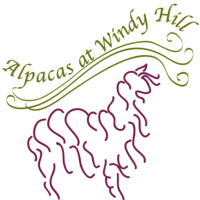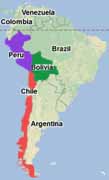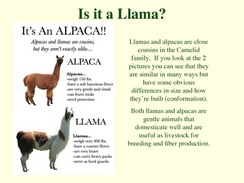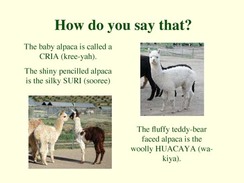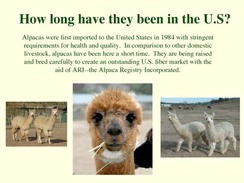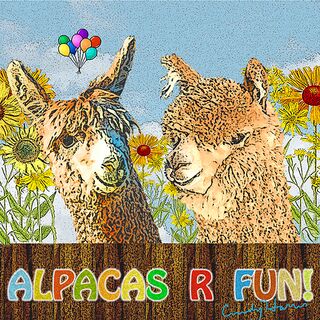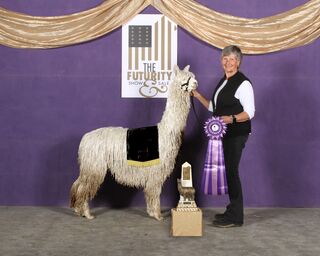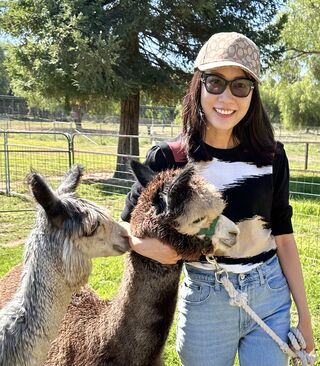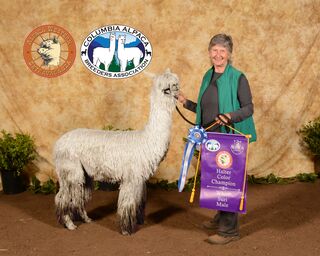Alpaca History
THE AMERICAN ALPACA
The Alpaca. What is this marvelous, mysterious creature, and where did it come from? The answer to this question is pieced together from many sources. Our answer is "intelligent conjecture" based on these sources. These amazing creatures known as “Alpaca” are descendants of the wild Vicunas of the Andean Altiplano. The proof of this hypothesis can be found in strikingly similar dental characteristics. The larger cousin, the “Llama” was most likely domesticated from the “guanaco”. Archeological digs indicate that the domestication of the wild South American Alpaca began approximately 7,000 years ago by the Pukara Indians in the Lake Titicaca region of Southern Peru. The ancestor of the camelid family actually originated in the North American Southwest approximately 50 million years ago and then migrated from North America to South America, Asia and Northern Africa. These camelid forefathers then became extinct in North America. Present day Alpacas are in the family -Camelidae, species - Lama guanicoe. In the real world this means that they are distantly related to Bactrian and Dromedary Camels and cousins to the domesticated Llama and the wild Vicuna and Guanaco of South America. There are two basic types of alpacas – the huacaya and the suri. Basically the only difference between the two types is their fiber. The Huacaya is called the "Wooly" alpaca because the fiber grows at a ninety degree angle to the skin creating a very fuzzy, teddy bear appearance. The Suri or "Silky" alpaca has fiber that grows at forty five degrees to the skin and therefore falls in ringlets or locks creating a draping curtain of reflecting light. The fiber is hollow which creates the excellent thermal properties of all alpaca fiber. The outer cover of the fiber is similar to human hair in that it has overlapping scales. Fewer scales of longer length on Suri fiber make the fiber incredibly soft and silky to the touch. Alpacas were further refined as fleece bearing animals by the people of the Inca Empire. In the Incan culture, alpacas and llamas were a treasured commodity, utilized for garments, hides, fertilizer, fuel, and meat. The wool of the Alpaca and the Vicuna was used alongside cotton fiber to make cloaks & robes (mainly used by royalty), rugs, hangings and wall tapestries for palaces and temples, giving them a silk-like shine and colors that were not yet known in Europe. Their traditional clothing attire was a long robe without sleeves that was usually adorned with gold, precious stones and feathers. Mummified remains of alpacas, discovered by archeologists at ritual Incan burial sites, have fiber that is finer and much more consistent than almost any alpaca alive today. Inca rulers treasured suri fiber and it was an offence for anyone other than royalty to wear it. This could be the reason that we hear it described as the, “Fiber of the Gods.” Alpaca textiles created from this wonderful fiber were so durable that many have been found intact and are now housed in museums as treasures of the past. Presumably, the quality of the animal was significantly impacted by unsupervised breeding and llama cross-breeding in the generations following the destruction and assimilation of the Incan culture by the Spanish conquistadors beginning in the mid-1500’s. Most of the herds were scattered or killed by the Spanish to make room for their domestic herds of sheep. Suris faded in memory but a few survived in the hands of small campesinos, or towns of Quechaun and Aymaran Indians in the remote areas of the Altiplano on the borders of Bolivia and Peru. Over the years suris adapted quite successfully to the harsh conditions at elevations of 14, 000 to 17,000 feet above sea level. But the numbers did not increase significantly. Initially, the Spanish conquistadors attempted unsuccessfully to transplant the alpaca into Spain in the early 1700’s. In addition, there were many other minor attempts, with varying degrees of failure, to establish herds of alpacas in Europe, Asia and elsewhere. It was not until the 20th century that successful importation of Alpacas created viable herds in countries other than Peru, Bolivia and Chile. Today, the most sizable populations of alpacas outside of South America are in Australia, New Zealand, Canada and the United States, all of which were established in only the last few decades. Peru produces an average of about 3.5 million kilograms of fiber annually, which represents 90% of the total world production. Only about 6% of the fiber exported from Peru is Suri (Safley, 1998). The origin of the Suri is obscure, but it has existed as a distinct "type" since the time of the Incas. Although statistics in Peru are not very precise, the population of suris is estimated to be under 60,000. They live predominantly in the southern region of Puno and have a total yearly production of around 550,000 pounds of fiber The first importation of Huacaya alpacas to the U.S. was in 1984. The first importation of Suri Alpacas into the United States was in 1991 and all the animals came from Bolivia. Further importations from Peru and Chile have increased the available gene pool in the United States. Based on year 2000 data from Michel Brothers of Arequipa as presented to the Suri Network, there are an estimated 150,000 suris in the world. Most of those suris are located in Peru, Bolivia and Chile. A mere 7,000 make up the U.S. Suri alpaca herd. 57.3% of those are white. With such a limited number of these fabulous animals it is our goal to continue increasing the U.S. herd with high quality pure colored suris. Only by increasing the numbers of suris through quality genetic breeding practices can we ensure the survival of these magnificent creatures. What are the uses for Suri fiber? It was not to be expected that a fiber with the amazing qualities of Alpaca would remain obscure and unused forever. Following the fall of the Incan empire and the dispersal of suris to the mountainous terrain of the Altiplano, not much is known or written until the 1800s when shippers of wool from the sheep of South America started using “Llama” (llama & alpaca) fiber as ballast to fill the holds of their ships. When the ships arrived in England the ballast fiber was usually discarded. Sir Titus Salt, 1803–76, English textile manufacturer and inventor, became curious about this very soft, fine material. He secured some of the fiber from the ballast and found it to have exceptional strength for its diameter. There was a wider range of colors than was found in sheep’s wool. It felt softer because it has less and longer scaling (as seen under a microscope) than sheep’s wool. It was lighter in weight, due to being partially hollow. Unlike the sheep wool, there was no grease (lanolin) and was therefore naturally much cleaner. With such properties it seemed natural that this fiber should be processed into textiles just as the Inca had done centuries before. Sir Titus invented a machine for making worsted from coarse wool and a process for spinning and weaving alpaca that created some wonderful worsted cloth. In 1851 he started to build, on the Aire River, extensive textile works and a model manufacturing town, called Saltaire, in which he attempted to embody his concepts of ideal factory conditions for workers. Sir Titus’ mill ran for a number of years, allowing a few people to own and admire the clothing made from Alpaca. Unfortunately other mills refused to make changes to handle the new fiber, and when the shippers found there was a market for this “throw away fiber” the prices rose and Sir Titus could not generate enough interest to keep Alpaca clothing popular. Various examples of people attempting to introduce Alpaca fiber to the general public have been documented but the difficulties of exportation from South America and the limited supply of fiber continued to keep product supply limited. In 1874, the Farr Alpaca Company of Holyoke Massachusetts, began production of Alpaca fabric. It was one of the few companies importing Alpaca fiber from Peru into the United States. The first goods shown were so well received that it was necessary to bring the mill to its full capacity of 255 looms. At the peak of production, The Farr Alpaca Company employed 600 people and had 360 looms working. Further examples of Alpaca fiber usage throughout history include an early 1900’s translation on the APPEARANCE OF 'ABDU'L-BAHA describing a prophet in the following manner. “His dress was that of the Oriental gentleman of the highest classes, simple and neat and very graceful. The color of His apparel was light, the outer robe being made of alpaca. On His head rested a light fez.” (The Living Age, Volume 2, Issue 23, October 19, 1844) One British publication of the 1800’s ran an article on the alpaca listing several novelty breeders including, “Among the English amateurs may now be ranked Prince Albert, who, for the last year, has had a pair of alpacas at Windsor……..and the Earl of Derby.” It is said that Queen Victoria wore clothing made from fleece from Prince Albert’s alpacas and was a great proponent of its qualities and uses. Worsted Alpaca cloth was used to create portions of the dress uniform coats during the U.S. Civil War. “The original used wool cording for the collar and cuff trim. The lining was of black alpaca.” During the 1st World War, Alpaca was rediscovered by some unknown person who caused the creation of under-suits of Alpaca to be worn by aviators under their leather garments. Examples of leather bomber jackets with Alpaca linings can still be found. In Europe the popularity of Alpaca began to take hold, and many English and French servicemen sought out supplies of Alpaca garments and readily purchased them. A few US servicemen brought home Alpaca clothing for themselves or for loved ones. As a luxury fiber, Alpaca continued to be used in the creation of high fashion outer and specialty wear around the world. The use of Alpaca became a viable option for orthodox Jews who needed to avoid certain cloth combinations to remain within the boundaries of their teachings. The forbidden mixture was called Shatnez. “The Torah forbids us to cover ourselves with any type of garment or fabric that contains both wool and linen. This would include a fabric, which is woven with both wool and linen or a garment, which is made of different materials and contain in them wool and linen that are permanently connected, (i.e. sewn or pasted). We are forbidden to wear such a mixture. Other materials, such as camel's hair, mohair, angora, cashmere or alpaca wool, present no shatnez problems.” Alpaca coats are not Shatnez and therefore valued by the Orthodox Jews. Today's Alpaca In today’s marketplace the leading use of Alpaca fiber is in designer fashions and the production of durable and warm outer garments. From Bolivia to Japan to New York, designers are discovering the lightness, luster and smooth texture of Alpaca and creating with it. Beatriz Canedo Patino, a leading Bolivian designer, is a master fashion designer. The simplicity and versatility of her designs have given her international recognition. Her products have earned her several awards, such as The Golden Thimble Award and The Gold Plate (for the best export quality product of Bolivia). Her company, BCP Alpaca Designs SRL is a leading Bolivian business, and a leading player in the international market, via exports to Europe, North America and the Far East. Among her clients, she is honoured to mention His Holiness, John Paul II, for whom she created a long cape in baby alpaca. Queen Sophia of Spain, Mr. & Mrs. Clinton, Mr. & Mrs. Jacques Chirac, Queen Silvia of Sweden, several Latin American Presidents and their First Ladies and many other prominent clientele. BCP Alpaca Designs SRL specializes in designing and manufacturing men's and women's tailored lines, such as coats, suits, capes and accessories. Their aim is to upgrade the recognition of camelid fibers in the world as an ecological, luxurious, rich, soft and durable fiber. Ms. Canedo Patino made comments in a recent article putting the use of alpaca fabric into perspective. "The alpaca cloth, known as 'The Other Gold of the Incas' by the Spanish conquistadors, is also called 'Nature's Miracle Cloth'. The elegant appearance of this rich fabric is striking: it is velvety soft to the touch, silky and highly lustrous, as well as being particularly light. These qualities are complemented by the fabric's extreme durability. The unique alpaca cloth retains its superior look throughout the years, the fibre being naturally restorative. With minimal care and soft brushing the cloth fibres regain their original beauty year after year. In addition, alpaca is water-repellent because of the fibre's natural lanolin content. Finally, alpaca is insulating and has outstanding thermostatic qualities. It keeps the wearer cool in the summer and warm in the winter, allowing the body to breathe." Suri fibre is in high demand for its superb lustre, light weight and exquisite softness. Leading designers believe it to be the finest and most elegant material in the world. It has a particularly sensual feel and appears almost luminous. Maria Bravo (an American designer committed to the alpaca) believes it to be the most sensual and luxurious fibre in the world. When compared with cashmere or mohair, Beatriz Patino remarks "I love cashmere, but suri has certain qualities that make it finer than cashmere. It has beautiful sheen; it is very durable and very light. Cashmere can lose its lustre after a couple of years whereas suri retains it for decades.” “Fashions are always changing. For now, ecology is definitely in, and therefore are the natural colours. Suri is becoming known as "the green fur". It is the only natural fibre used for fur that does not require an animal to be slaughtered. Beatriz says alpaca offers the raw material to create both beautiful and practical garments in the same piece. A coat must not only look good, but also protect you. It has to be very functional. Classical styles also lend credit to the longevity of the alpaca fibre. Michelle Wyles sums it up best when she says, "Suris are rather unlikely looking possessors of the finest, shiniest and most desirable dreadlocks that, until lately, were the well-kept secret of the high Andes." (An Interview with Beatriz Canedo de Patino, by Stephanie Pope. The Australian Suri Company) The biggest importers of Alpaca fiber in today’s market are Japan, Italy, Germany and Great Britain. Houses like Fujii Keori, Hosokawa, Fujimata, Nayatake Keori, and others in Japan create the most fascinating diversity of fabrics to tailor coats that retail for as high as U.S. $2,000 - $3,000 in top department stores such as Mitsukoshi, Takashimaya, and Sogo. Lanerie Agnona in Italy is the world’s leading manufacturer of top-quality fabrics from suri, which mainly are used in blankets and high-end women’s coats. Other Italian houses that use suri to create prestigious collections are Ricceri, Loropiana, Colombo, and Piacenza. But high fashion is not the only use for Alpaca fiber. As inventive individuals uncover the various qualities of Alpaca they are taking it in new directions. This article in Alpaca World magazine points out a new experimental use for the ever versatile fiber. “Alpaca fibre’s fire retardant properties are being exploited for use in aircraft interiors and boat furnishings by a British company, Dalton Lucerne Rare Fibres, based in the silk town of Macclesfield, in Cheshire. Alpaca weft yarns, woven on polyester or silk warps, have been found to pass the United States Federal Aviation Authority regulations. These fabrics are targeted at the executive jet and yacht markets and have already been used in aircraft for a Middle Eastern client. Another company creates Designer interior upholstery products called FEEL, making a play for the new age upholstery market. What is it that makes Suri fiber such a sought after commodity? It is the qualities of the fiber that create such a demand. Many fiber animals, including cashmere goats, llamas, vicunas and guanacos, are "double coated" animals. That is, in addition to their highly prized soft undercoat of fiber, these animals also have longer, coarser guard hair. In the wild, these guard hairs provide significant additional protection against abrasions, rain and cold. But in luxurious textiles, the prickly guard hairs, if not removed either by hand or by machine, produce a much coarser, scratchy product. In contrast to other animals, the modern alpaca is a predominately "single-coated" animal, with only somewhere between 3 to 15 percent of guard hair in the prime fleece of the better animals. Suri alpaca fiber can easily be worn against the skin. Alpaca is now mixed with wool, mohair, silk, cotton to achieve a range of qualities in the finished product. Alpaca is lighter and warmer by weight than wool or cashmere. It is a natural fiber with 22 shades and very little lanolin so it can be processed without chemical cleaners or dyes. Because it contains almost no lanolin it does not attract allergens like pollen and dust. Those who cannot wear wool can comfortably wear alpaca so it is also referred to as hypoallergenic. It is durable and easy to clean. Other than mohair, alpacas produce the strongest animal fiber in the world and is recognized for its durability. Exhibiting natural restorative properties, alpaca, with respectful and minimal care can last a lifetime just like the extraordinarily preserved fine woven garments that were recently discovered in Peruvian ruins dating back 2500 years. It’s thermal properties allow it to breath and easily regulate the perfect temperature around your body. Alpaca fiber has adapted to the needs of the animal. Each individual fiber has microscopic air filled cells which means that the alpaca has developed more natural thermal and wicking capacity in its fiber than almost any other animal. In addition, alpaca is water repellant because of the minimal natural lanolin content it subtly retains and can resist the solar radiation effectively. These characteristics guarantee the animals a permanent and appropriate coat to survive the extreme changes of temperature as found in the Altiplano. Highly regarded by outdoor enthusiasts, garments made from alpaca offer wonderfully cozy, featherweight warmth that sheep’s wool, goose down or even the new synthetic fabrics like Gortex and polar fleece cannot possibly begin to compete with. But those are just the facts. Let’s talk about the feelings. Alpaca fiber feels like a warm breath upon your skin. So silky and soft that you hardly know it is there and yet catching the light when you move to show its eternal luster even if the garment is thirty years old. This is truly the fiber that spoils you for anything else. Television advertisements can say that you should use a certain hair color, “ because I’m worth it.” For my money, I’ll take Alpaca because I deserve to be spoiled by such luxury, comfort and enduring beauty.
Acknowledgments:
1 "Return of the Camel – A Brief Alpaca History," Ken Madl, Alpacas Magazine, Summer 1997.
2. Oral Presentation by Dr. Jane Wheeler at the AOBA/ARI Mid-Winter Conference in Reno, Nevada, February 1998.
3. "Animal Breeding and Production of American Camelids," Rigoberto Calle Escobar (1984).
4. "Gold of the Andes – The Llama, Alpaca, Vicuna and Guanaco of South America," Ochoa, MacQuarrie and Portus (1994). "Peru," Rachowiecki, The Lonely Planet Publications (1996). Safley, M. (1998), Suri Network.
Suri Alpacas. Internet: www.surinetwork.org Tuckwell, C. (1994)
The Peruvian Alpaca Industry. Rural Industries Research and Development Corporation. Kingston ACT. Walker, L.B. (1996).
About the Suri Alpaca and its Fibre. Suri Network News. Vol 1, No. 2, June 1997. Suri Network, Juan P. Pepper, ARI Journal & Newsletter Sandi Keane, Pinjarra Alpacas & Chair, Chairman of the Australian Alpaca Association Suri Breed Standard Committee Alan Hamilton , Chairman - Alpaca Cooperative Ltd. Australian Alpaca Industry Seminars 1998 Andy Tillman, Suri Network. Suri Alpacas. Internet: www.surinetwork.org National Geographic Magazine, Vol. 196, No.4, November 1999. The American Wool Handbook, Wernere Von Bergen and Herbert R. Mauersberger, Textile Book Publishers, Inc. NY NY, 1948 Kelowna Farms Alpacas, Australia Dr. David R. TenHulzen, Park View Alpacas Dennis Dey - Farm Management Consultant, Canadian Alpaca Association Kathryn A. Jakes, Ohio State University, Columbus, OH THE PILGRIMAGE OF LOUIS G. GREGORY. originally printed by R.L. Pendleton, Washington, 1997 edition printed by alpha services, The Living Age, Volume 2, Issue 23, October 19, 1844 (Periodical, Cornell University From the Polytechnic Review.) Summer, 2002 - Alpaca World Magazine
Tuesday, June 23, 2020
